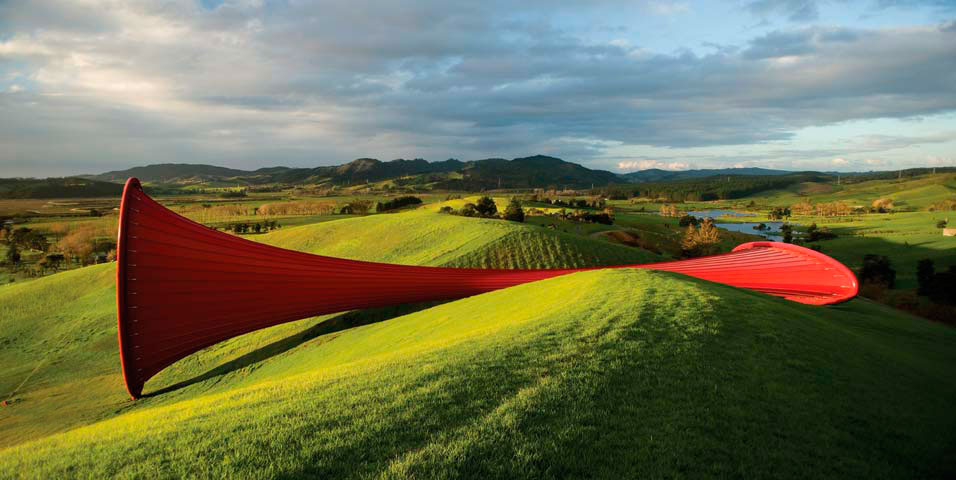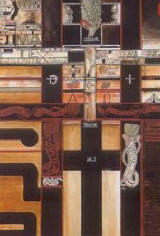 |
| Cloud Gate (2004), Millennium Park, Chicago |
 | ||||||
|
1.Research Kapoor's work in order to discuss whether it is conceptual art or not. Explain your answer, using a definition of conceptual art.
"Conceptual Art" is a contemporary form of artistic representation, in which a specific concept or idea, often personal, complex and inclusive, takes shape in an abstract, nonconforming manner, based upon a negation of aesthetic principles. It's not about forms or materials but ideas and meanings. It would be something but it wouldn't be an object. It is a kind of art that is something but not at the same time, like you don't know why it had been made, therefore, it's a challenge for all viewers. It's rather an experience than something to sell.
2. Research 3 quite different works by Kapoor from countries outside New Zealand to discuss the ideas behind the work. Include images of each work on your blog.
 |
| Sky mirror , 2006 |
"Anish Kapoor's Sky Mirror is a breathtaking, 35-foot-diameter concave mirror made of polished stainless steel. It is nearly three stories tall at the Fifth Avenue entrance to the Channel Gardens at Rockefeller Center, Sky Mirror offers a dazzling experience of light and architecture, presenting viewers with a vivid inversion of the skyline featuring the historic landmark building at 30 Rockefeller Plaza. (Tishman Speyer). I think Kapoor placed this mirror in this populated place is so that lots of people can see the work and I think he is trying to provoke the idea of "looking at things in a different way". Not everything is the same if you look at it different. For example, the tower in the mirror is up side down, its just a tower but after reflecting in the mirror, its something else, where you look at the tower differently and think differently.
 |
| Anish Kapoor, Shooting into the Corner (2008-2009) |
Shooting in the corner is a mixed media / Dimensions variable and where the installation is at Mehboob Studies, Mumbai, India 2010."The objects provide a survey of Kapoor’s most recent work. Since 200, the artist has intensively explored the possibilities of wax as an art material which is produced especially for him. The artist adds pigment to the wax to achieve his typical object coloring. On view in the central exhibition hall will be a work entitled “Shooting into the Corner, 2008/2009”: a catapult that shoots prefabricated projectiles against the wall of the exhibition hall at a speed of about 50 kilometers per hour. " When I first looked at this work , it really reminds me of cruelty killing because of the red wax and the canon. It doesn't really give me a good inspiration at all. Even though, I still liked the idea and how it was presented.
 |
| ‘Leviathan’ (2011) |
Leviathan is 35 meters high and tautly-stretched PVC over a giant metal frame and is the highlight of the whole room. People can walk around it and inside it.Kapoor said: 'My ambition is to create a space within a space, responding to the great height and light of the nave of the Grand Palais.I can really see how he creates a space within a space, the giant structure made the room so small and also the people. The size is really shocking and I think that's why it is the highlight of the exhibition because it's just so easily spotted.
3.Discuss the large scale 'site specific' work that has been installed on a private site in New Zealand.This work is called Dismemberment, Site 1. It was located in Gibbs Farm in New Zealand. It is made out of steel tube and tensioned fabric with a length of 85 meters. It is obviously a contextual art. The red colour is very bright so it really stands out of the green field. It reminds me of a trumpet horn as if the wind blows in from the right end the other end would enlarge the said of the wind. It really showed how space is important to structures like these.
It is installed in New Zealand on the private "art park" known as "The Farm" and owned by New Zealand businessman and art patron Alan Gibbs. The materials were mentioned above which is steel tube and tensioned fabric. I think the idea behind his work is wanting to challenge his viewers to look at a normal space or a site differently by putting something so unusual in it. I think he is trying to tell us that everything we see isn't what we see and even if we turned one direction to look at it, you will always find something new and different.
5. Comment on which work by Kapoor is your favourite, and explain why. Are you personally attracted more by the ideas or the aesthetics of the work?
I think for me,it is hard to choose a favorite since they are all really good. The reason that it attracts me is the bright and solid colour he uses and the size of his sculptures. How it is so big and tall that you have to look up and stand back to view the whole thing instead of going to a gallery and one glace I can see every work in the room. I guess I am more attracted to the aesthetics of the work since the ideas behind his works are pretty hard to find out and to understand but that's how his work is interesting because I can hardly understand why , therefore, his works will always leave a question mark in my mind.
Conceptual Art. Retrieved from:
http://www.caroun.com/art/conceptualart/conceptualart.html
http://www.caroun.com/art/conceptualart/conceptualart.html
Sky Mirror. Anish Kapoor . Retrieved from:
http://www.publicartfund.org/pafweb/projects/06/kapoor/kapoor-06.html
Shooting into the Corner.ANISH KAPOOR. Retrieved from:
http://www.mak.at/mysql/ausstellungen_show_page.php?a_id=850
The next big thing: Giant PVC sculpture stuns the Paris arts scene.Mail online. Retrieved from:
http://www.dailymail.co.uk/news/article-1385590/Anish-Kapoor-Leviathan-sculpture-unveiled-Grand-Palais-Paris.html
Gibbs farm.Retrieved from:
http://www.gibbsfarm.org.nz/kapoor.php
Gibbs Farm, landscape transformation. Retrieved from:
http://mydesignstories.net/profiles/blogs/gibbs-farm-landscape-transform
Anish Kapoor.Retrieved from:
http://www.answers.com/topic/anish-kapoor




























